Baking your own bread is apparently a dangerous pastime. "Beware of making that first loaf," cautions the late, great cookery writer, Margaret Costa. "Unless you are quite exceptionally lucky in your baker, and/or have a very easy-going family, you will find it difficult to go back to shop bread again."
Perhaps bread has improved since those lines were written in 1970, or maybe I'm just exceptionally lazy, but however much I enjoy pretending I'm Barbara Good, I've not yet found a recipe quick or reliable enough to threaten my bakery habit. (Soda bread, as taught to me by the wonderful Pierce and Valerie McAuliffe of Dunbrody Cookery School in Wexford, is the exception to this, but I lack sufficient Irish genes to want to wake up to it every morning.)
I decide that if I'm going to be eating homemade bread on a regular basis, it really ought to be wholemeal, to offset the enormous amounts of butter I will in all probability be topping it with. Unfortunately, wholemeal bread is, according to many experts, a tricky thing to get right, as the lower gluten content of the flour makes for dense results – the classic worthy loaf beloved of those who also, according to some wits, enjoy knitting their own yoghurt. I need to find a loaf that's quick enough to bake twice a week, yet tasty enough to keep me away from the seeded bloomers.
Need to knead?
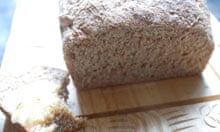
I start off with the most basic recipe I could find, as easy as 'mud pie', according to Margaret Costa. No kneading, no punching down, no extra ingredients – the kind of bread you could feasibly knock up before going to bed. To make it, combine 433g of wholemeal flour with 2tsp salt and 4tsp of soft brown sugar, add a sachet of fast action yeast, then mix to a smooth dough with about 300ml of warm water. Put the dough in a greased 900g loaf tin, and into a warm spot under the protective embrace of a tea towel until it has almost doubled in size (on a hot day, this takes my batch 45 minutes).
When it's risen to the occasion, the loaf goes into a 200C oven for 40 minutes until brown, and is then turned out to cool. (The most difficult thing about baking is stopping yourself tearing into the loaf straight from the oven: despite its tempting smell, it will, in the words of one enthusiast, "give you worse indigestion than Mr Cresosote".) Although it hasn't grown as much as I had hoped, the texture is pleasingly crumbly, and the flavour good. But, in the words of an unkind observer, "there's something of the doorstop about this bread". Not bad, given the speed of its creation, but certainly not perfect.
Long rise
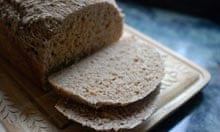
I decide to try out a few different methods with the same basic recipe. If anyone should be an expert on 1980s middle-class favourites, it's Delia, so I'm intrigued by her suggestion that "the longer you leave it [the dough] to rise at room temperature, the better the bread". One recipe I read even goes as far as to make the mixture the night before baking, so I decide to give this a try, using the Margaret Costa no-knead method, a version of which is also recommended by Delia herself. (If you're leaving dough for this long, even at room temperature, it's best to cover it with a piece of oiled clingfilm to prevent it developing a dry crust.) The results are sadly disappointing; the bread has a sour, yeasty taste which, according to Leiths' handy troubleshooting tips, suggests the dough was risen for too long a time. Regretfully, I bin it.
Slam dough
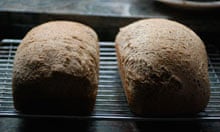
Like Margaret Costa, Brittany-born and Bath-based baker Richard Bertinet scorns kneading – so much so that he's developed his very own technique instead, inspired by his French heritage. To 'work' the dough a la M Bertinet, stretch it out, slam it down on a clean, rather than floured surface, and then fold it over to trap air without adding extra weight.
I use a little more water than for the previous loaf, as the dough needs to be wet and sticky rather than smooth and slippery and get to work slamming – an oddly satisfying pastime, which you can see Richard himself demonstrating online. After leaving it to prove for about an hour, I gently release the billowing mass from the bowl and stretch it out, before folding it in on itself, putting it in a loaf tin, and leaving it to rest for 45 minutes. When I remove it from the oven, I'm pleased to see it's taller than the first loaf, but I'm not happy with the texture, despite my efforts – although edible, it's still indisputably heavy.
The classic method
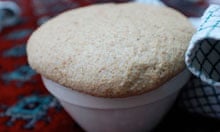
It's time to try a more traditional technique, as outlined in my trusty Leiths baking Bible. After stirring the flour, yeast, salt and sugar together with water, I turn the dough out on to a lightly floured work surface and knead in the time-honoured fashion for about 10 minutes, until it feels silky and elastic. It rests in an oiled bowl until doubled in size and then I'm finally allowed to 'knock-back' the dough – ie sock it a hefty punch – before tipping it on to the work surface for a brief final pummelling. Into the tin it goes to prove, and when it's doubled in size, it's ready to cook. This is the best risen of the loaves so far, but texture-wise, although it's less heavy than my Bertinet-method bread, I'm still not satisfied. I'm beginning to wonder whether this could be more to do with the ingredients than the method.
Little and often
Finally there's the Dan Lepard technique, as put forward on this very website. Dan explodes the idea that kneading helps to 'develop the gluten' and give a lighter texture:
"When dough is mixed relatively slowly by hand on a worktop, even by the most accomplished bakers, the changes that occur will be mostly due to the length of time since the water was first added, and the characteristics of and interactions between the ingredients. So you can knead the dough fast, slow, or even not at all, and end up with similar results."
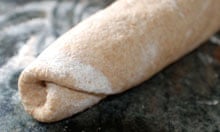
He favours dough kneaded "briefly and intermittently" after a 10 minute pause to allow the flour to absorb the water: three 10 second kneads at 10 minute intervals, followed by 15 minutes rest, after which the dough is flattened into a rectangle, rolled up tightly, and placed, seam-side down in an oiled and floured loaf tin until it has doubled in size, and then baked at 220C for the first 20 minutes, and then 200C for a further 20. I heave a sigh of relief when I eventually cut into it: finally, I have myself a winner. This loaf boasts a good, chewy crust, and a fine, relatively dry crumb. If it wasn't my fifth of the morning, I'd have seconds.
Ingredients
With my method in place, it's time to take a look at the ingredients. Although basic bread recipes tend to be fairly standard – flour, yeast and water, with sugar acting as extra food for the yeast, and salt as seasoning – there are some variations which might help me make a lighter loaf. One is fat: not an essential, but often included to give a 'finer texture'. I pour in 50g of melted butter to my mixture after adding the water. The resulting bread seems to have a moister texture, without the slightly gummy heaviness of some of the previous loaves, and a richer, fuller flavour. Butter is in.
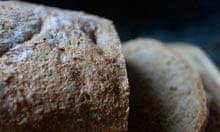
Dan Lepard, meanwhile, has another secret weapon up his floury sleeve: vitamin C, which apparently counteracts the glutathione which is responsible for wholemeal bread's heavier texture. Half a 500mg tablet, crushed to a powder and added along with the yeast, is apparently sufficient to stop the pesky chemical in its tracks. It proves well-nigh impossible to find vitamin tablets that don't taste like children's sweets in my local area, so I plump for lemon flavour, on the basis that I've got some smoked salmon in the fridge crying out to be made into an open sandwich, and hope for the best. Thankfully it's undetectable in the end result, which has a nice open structure, and a near fluffy texture. Added vitamins also get the thumbs up.
The last approach is to dilute the wholemeal flour with strong white flour: Leiths suggest a 1:1 ratio, which seems a bit like cheating, so I opt for Darina Allen's more restrained 1:5 mix. When I cut into the finished loaf, it has significantly larger air bubbles, and a lovely chewy crust. Adding a soupçon of white flour may be a bit of a cop out, but I reckon it's worth it.
Conclusion: Margaret Costa's recipe is one I would certainly make again if I was short of time – it's marvellously quick, and very palatable. Although my perfect recipe takes a little longer, there's actually very little work involved, and it's all very easy indeed; far simpler, in fact, than trying to remember where you left the manual for the breadmaker.
Felicity's perfect wholemeal bread – with thanks to Dan Lepard
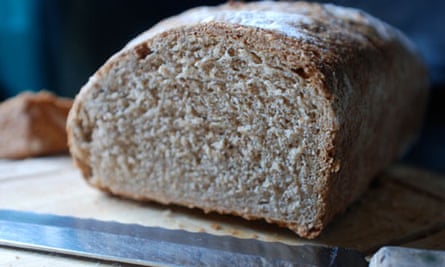
400g strong wholemeal flour
50g strong white flour
2 tsp easy blend yeast
Half a 500mg vitamin C tablet, crushed
2 tsp salt
3 tsp brown sugar
400ml warm water
50g melted butter
1. Tip the flours, yeast, vitamin powder, salt and sugar into a bowl and mix well. Add 300ml water, and stir in well, then pour in the butter and work in well. You should have a soft, sticky dough: if not, add a little more water. Cover and leave for 10 minutes.
2. Tip out on to a lightly oiled work surface and knead for 10 seconds, then put back in the bowl and cover. Repeat twice more at intervals of 10 minutes, then leave the dough to rest for 15 minutes.
3. Flatten the dough into a rough rectangle about the length of your baking tin, then roll up tightly, and put into a greased tin, with the join facing downwards. Cover and leave to rest in a warm place until it has doubled in height (at least 1½ hours).
4. Pre-heat the oven to 220C. Bake the bread for 20 minutes, then turn the temperature down to 200C and cook for a further 15–20 minutes, until the crust is a deep brown, and the loaf sounds hollow when tapped. Turn out on to a cooling rack.
What's your favourite bread recipe; or do you prefer to leave such things to the experts? And tell us honestly, are breadmakers a godsend, a convenient compromise, or an utter waste of money and space?
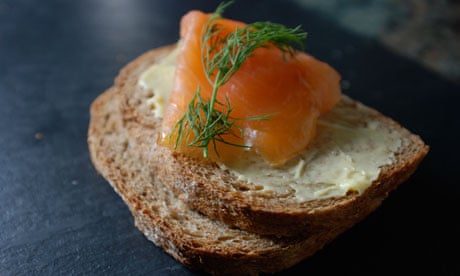
Comments (…)
Sign in or create your Guardian account to join the discussion